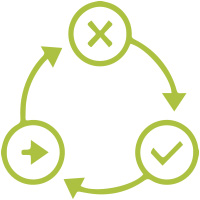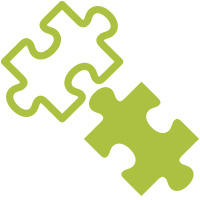Creativity: Can you lose yourself to find yourself?
Rate this article and enter to win
Do you see yourself as creative? Maybe you don’t play a musical instrument and didn’t wow in grade school art class. Perhaps you see your creativity in your Instagram posts but not in your economics paper or the way you fixed your wonky bike. Maybe you’re a pragmatist: Creativity has value, but life’s too short. If so, you may be sidelining a fundamental aspect of yourself. We are all wired to create, and we can approach any situation in life with a creative spirit. We all have the capacity to dream, explore, discover, build, ask questions, and seek answers. For more, click on each
 |
Scott Barry Kaufman, PhD, is scientific director of the Imagination Institute in the Positive Psychology Center at the University of Pennsylvania. |
 |
Carolyn Gregoire is a senior writer at The Huffington Post and co-author, with Kaufman, of Wired to Create: Unraveling the Mysteries of the Creative Mind (Perigee, 2015). This piece is adapted from that book. |
If I’m not Elon Musk or Beyoncé, what can creativity do for me?
Creativity expands our minds and self-confidence
When we engage in creative activities, we tend to become absorbed in what we’re making, entering a kind of flow state that can induce a sense of control, enjoyment, and accomplishment.
Creative work can also act as a positive distraction, directing our attention to an enjoyable activity and potentially broadening it in a way that facilitates new modes of thought.
Creative expression opens us up to who we are; our unique set of qualities, experiences, and contradictions.
People who engage in a creative lifestyle tend to be more open-minded, imaginative, intellectually curious, energetic, outgoing, persistent, and intrinsically motivated by their activity. They report a greater sense of well-being. One study found that inspiration leads to increased optimism, belief in one’s capabilities, self-determination, and self-esteem.
Creativity helps us cope and heal
Creativity truly carries healing power. Creative work can help us make meaning out of challenges and suffering that may feel senseless. This seems to contribute to psychological growth after trauma. Creative work is also a sign that growth or healing has occurred.
Paul Klee, the Swiss painter, suffered from a rare autoimmune disease that crippled his hands. In the year after his diagnosis, Klee created more than 1,200 works, including some of his largest, most original pieces. “I create—in order not to cry,” he said.
Does creativity come from intelligence or… what?
Creativity is not merely expertise or knowledge, but is instead informed by a whole suite of intellectual, emotional, motivational, and ethical characteristics.
Openness, complexity, risk taking, and unconventional thinking
In the 1960s, the psychologist Frank X. Barron showed that while IQ and academic aptitude were relevant (to a moderate degree) to creativity, they did not explain the particular spark of the creative mind.
In his studies, the common personality strands that seemed to transcend all creative fields were:
- An openness to one’s inner life
- A preference for complexity and ambiguity
- An unusually high tolerance for disorder and disarray
- The ability to extract order from chaos
- Independence
- Unconventionality
- A willingness to take risks
So what kind of mind is especially creative?
Through their work, creative people find a way to bring together their many interests, influences, and personality elements.
Creative minds are a system of characteristics
Creativity is not a single characteristic, but a system of characteristics that feed off and amplify each other. These include:
- Intellectual functioning and knowledge
- Relevant skills and thinking styles
- Psychological resources such as confidence, perseverance, and a willingness to take risks
- Inner motivation and a love of one’s work
- A complex suite of positive and negative emotions
- Environmental factors, such as access to key resources
Creative people are able to make the best of their traits and skills
This ability to adapt to changing circumstances is reflected in three main “super-factors” of personality that are highly correlated with creativity:
- The tendency to explore and engage with novel ideas and scenarios (openness to experience)
- A nonconformist mindset and independent thinking
- The ability to put in the hard work, be conscientious, and be sensitive to the audience
Creative people are complex above all
The eminent psychologist of creativity, Mihaly Csikszentmihalyi, observed, “If I had to express in one word what makes [creative] personalities different from others, it’s complexity. They show tendencies of thought and action that in most people are segregated. They contain contradictory extremes; instead of being an ‘individual,’ each of them is a ‘multitude.’”
This dance of contradictions may be precisely what gives rise to the intense inner drive to create. Creative work brings together and harmonizes these conflicting elements, which exist to some extent in everyone.
Is it true that creativity is linked to mental illness?
Although we need not be mentally ill to be creative, and being mentally ill is not enough to make us creative, mental illness and creativity do seem to be linked in subtle ways. For example, having an extremely open mind makes flights of fancy more likely.
Creative people may appear simultaneously mentally ill and mentally healthy
The study of creative genius has revealed fascinating and perplexing contradictions. The psychologists Frank X. Barron and Donald MacKinnon found that creative writers scored high on some measures of mental illness. The kicker: Creative writers scored extremely high on all the measures of psychological health too! They appeared a loose bundle of paradoxes and perplexities. Barron began to question the value of the tests themselves and the labels we put on individual personalities.
Creative people are unusually self-aware
Barron identified a key characteristic of creative people. They seemed to become more intimate with themselves—they dared to look deep inside, even at the dark and confusing parts of themselves.
Being open to and curious about the full spectrum of life—the good and bad, the dark and light—may be what leads writers to score high on some characteristics that our society tends to associate with mental illness, while it can also lead them to become more grounded and self-aware.
In truly facing themselves and the world, creative people seemed to find an unusual synthesis between healthy and “pathological” behaviors.
I’ve suffered horribly— is that why I’m creative?
That may be part of it. Great artistic achievements often arise out of intense suffering.
Creativity involves finding meaning in human suffering
We all love a good story of triumph in the face of adversity, in which the survivor passes on their new wisdom and compassion to others. Much of the music we listen to, the plays we watch, and the paintings we look at are attempts to find meaning in human suffering. We all experience suffering. Afterward, many people not only return to their baseline state of functioning but learn to truly thrive.
Creativity can be part of growth after traumatic experiences
When we mull over a negative experience, we are working hard to make sense of it and find a place for it that still allows us to have a strong sense of meaning and purpose. That process is grueling, but it can open the door to a new life. Up to 70 percent of trauma survivors report some positive post-traumatic growth. Adverse events force us to reexamine our beliefs and life projects—and that’s where their power and creative potential lies, says Marie Forgeard, a psychologist who has done extensive research into posttraumatic growth and creativity.
Adversity can reveal new possibilities and generate creative growth
Eminent creators, particularly in43ain. Indeed, loss and gain, suffering and growth, often co-occur. “No one should encourage artists to pursue tragedy so that they might become a good artist,” said Yoko Ono. “You don’t have to have tragedy to create.”
The myth of the tortured artist is just that—a myth. In reality, creative achievement draws on positive as much as negative life experiences.
If I’m happy, will that crush my creativity?
Positive events can powerfully shape our character, worldview, and beliefs. This phenomenon is sometimes known as post-ecstatic growth.
Positive experiences lead to growth and creativity too
Positive emotions seem to build a person’s psychological resources, broadening attention, inspiring new thoughts and behaviors, and stimulating creative thinking. This seems to allow people to see new possibilities and goals, sometimes acting as a catalyst for seismic shifts in worldview.
In a study by the researcher Ann Marie Roepke, an overwhelming majority of participants experienced at least a small amount of personal growth following a positive event. It was positive events grounded in meaning that were most likely to lead to growth—experiences of awe, wonder, inspiration, and connection to something greater than the self.
To be creative, must I retreat to a log cabin?
There is reason to believe that what goes in the human mind while we’re alone is every bit as important as what happens in our interactions with others.
Solitude is key to self-discovery and emotional maturity
Being alone forces us to reflect on all aspects of ourselves—even those parts that we normally choose to leave unexamined. That reflection can give rise to our most profound personal and creative insights.
Our culture has come to overemphasize constant social interaction, devaluing and misunderstanding aloneness. Of course, meaningful collaboration is sometimes important for creativity and brings different perspectives together. However, the act of creating requires time for ourselves, so we can hear our own ideas—both the good and bad ones. These ideas need space to be developed.
Creativity benefits from an outsider’s mindset
Expertise is important for excellence in any creative discipline. But if we’re entrenched in our own point of view, we can have trouble seeing other solutions. For this reason, the newcomers to a field are sometimes the ones who come up with the ideas that truly innovate.
By opening to experience and actively choosing to see things from different perspectives, we can increase our capacity to find links among seemingly unrelated pieces of information.
Living in and adapting to foreign cultures may also enhance this skill, which can give a major boost to our powers of creative thought.
How hard should I work (or play) at being creative?
Creativity can’t be bottled and sold, or tapped into at will—it works in mysterious and paradoxical ways, and rarely at our convenience.
The false dichotomy between work and play is damaging
As adults, cultivating a childlike sense of play can revolutionize the way we work. We tend to think of work—even when it is creative in nature—as serious and difficult. But playing gives us lightness and flexibility when generating new ideas, and helps motivate us to work long hours without becoming too stressed or depleted. Jane McGonigal, a video game designer, argues that many of things we do “just for fun,” like gaming, are actually crucial to our happiness, resilience, work performance, and creativity.
It is important to carve out spaces in which play is not only tolerated but celebrated. Adults who are more playful report feeling less stressed, better able to cope with stress, and having greater life satisfaction and other positive life outcomes. And, truly, maintaining a spirit of play keeps creativity and vitality alive as we get older. Play is intimately connected to intrinsic joy, creating a synergy that naturally leads to greater inspiration, effort, and creative growth.
Creativity means loving the work
“Follow your passion” is a cliché, and too simplistic, because passion can be a double-edged sword. Psychologist Robert Vallerand and his colleagues make a distinction between two types of passion:
- Harmonious passion: Here, people are not “following” their passions; their passion is part of who they are. They are impelled to create. Their focus is on mastery, learning, and growth, fueled by vitality and joy.
- Obsessive passion: This is characterized by anxiety about the creative work, and the social pressure or self-esteem that can be connected to achievements. Obsessively passionate people are compelled to create. There is less vitality and enjoyment, and a tendency to avoid challenges.
This difference matters. The entrepreneur James Clear wrote, “If you want to become significantly better at something, you have to fall in love with the process of doing it.”
Is inspiration really only a small part of success?
People who are open to experience are more likely to become inspired. Inspiration is associated with having a greater purpose in life. Inspired people are more intrinsically motivated by the love of the activity and less motivated by success or social status.
How much inspiration matters
Way more than 1 percent—inspiration and effort are jointly important! It’s the dynamic dance between the two that leads to creativity. Inspired people are more likely, not less likely, to do the hard work necessary to achieve their goals.
How inspiration strikes
There are three defining features of inspiration:
- Evocation: Maybe the spark is a role model, teacher, experience, or an eye-catching photo on Instagram. Evocation happens largely without your conscious thought.
- Transcendent awakening: This is a moment of clarity or awareness of new possibilities, like an idea or insight that you feel compelled to bring to fruition.
- Striving to transmit or express a new idea, insight, or vision: This is usually in response to a creative idea, material, or person.
Am I paranoid for sensing that my creativity isn’t always appreciated?
“The world in general disapproves of creativity,” said Isaac Asimov, the scientist and science fiction writer. The one absolutely essential ingredient of any type of creative achievement is thinking differently.
Creative people aren’t always popular in the moment
Think about some of the greatest creative minds and most important historical moments in art and science. The one thing they all had in common is that they challenged the status quo—and often were met with resistance and adversity. Frequently, their work was labeled a failure. The history of creative thought and social progress is littered with banned books, culture wars, persecuted artists, and innovations that changed the way we look at the world.
The creative act is breaking from tradition and routine. It is about creating new patterns, asking new questions, seeking new answers. Think of the initial hostility to jazz, which broke all the rules of music, and avant-garde visual arts movements, such as impressionism and modernism.
Deep down, we’re afraid of creativity
The fact that we celebrate new and original ideas after they’ve become widely accepted doesn’t mean that we truly embrace creativity. In fact, the opposite may be true. As a rule, we don’t like things that challenge our habitual ways of thinking, which makes creative work a dangerous endeavor.
Across the board, people, institutions, and decision makers deny creative ideas, even when they explicitly cite creativity as being among their goals or values. Research suggests that this bias interferes with our ability to recognize a creative idea; it causes us to take a negative view of creative ideas and projects relative to those that are more practical.
This bias indicates a fascinating paradox at the heart of our attitudes toward creativity; we desire it, and we also fear it. “Creativity takes courage,” said Henri Matisse, the painter and sculptor.
10 ways to nourish your creativity
Highly creative people do certain things differently. Here’s how you can learn from them.
 |
1. Allow yourself imaginative playGo ahead—dance, paint, explore a new place, be silly, and have fun. You might just find that it gets your creative juices flowing. |
 |
2. Be passionate about your creative processCraft goals that emphasize learning (like experimenting with sound) rather than mastery (like winning a Grammy). Visualize the desired goal, then possible obstacles. This helps identify useful strategies—like grit, optimism, passion, and hope. |
 |
3. Make time for solitudeSet aside a special time and place in your life for creative thinking and work, such as rising early to write, or meditating before a painting session. |
 |
4. Honor the emotional messiness that leads to intuitionInsights (those “Aha!” moments) are like gifts from the unconscious mind. Emerging research suggests that bringing together positive and negative emotions (emotional ambivalence) can help facilitate insights. Think of the bittersweet excitement of graduation. |
 |
5. Be open to experienceThe more an experience leads you to conceive of new possibilities for your life, the more you may grow. Try a new creative outlet or a totally different medium of expression. If you’re a writer, learn to play a musical instrument; if you’re a dancer, paint. Take a new route home, or seek out people with different values. |
 |
6. Cultivate mindfulnessLearn to observe and pay attention to your surroundings—e.g., while you’re walking across campus or cooking dinner—to cultivate everyday mindfulness. Sitting silently and focusing on the breath for five minutes a day is another great way to start meditating. |
 |
7. Let yourself daydreamWhen working on a creative project or assignment, try taking a five-minute daydreaming break every hour or so. Engage in a simple activity like walking, doodling, or cleaning. Consider this your creative incubation period, and see if you feel a renewed creative energy when you get back to work. |
 |
8. Cherish your sensitivity (even the painful parts)Rather than avoiding or denying hardships and challenges, choose to live with that intense sensitivity. This makes life more difficult, but it also brings great rewards. |
 |
9. Turn adversity into advantageRegular expressive writing (15–20 minutes) about a topic that triggers strong feelings in you is thought to help us better understand and express positive and negative emotions. This type of writing can improve psychological and physical health, and some cognitive functions, such as working memory. |
 |
10. Think differently, take risks, be prepared to failCultivate a spirit of everyday nonconformity by seeking out new experiences (like studying abroad), asking impertinent questions, and engaging with numerous solutions to a problem. Turn your fear of rejection into a more constructive emotion, like anger or pride, which can fuel creative work. |

Your best Instagram
“This was the biggest graduating class for the Culinary Arts Program at San Bernardino Valley College, so we wanted to make sure we popped out! From that point on, I was in charge of decorating our graduation caps.”
—Andres Dominguez, fourth-year undergraduate, San Bernardino Valley College, California
Follow us on Instagram, and don’t forget to use the hashtag #creativityfix
Wired to Create: Scott Barry Kaufman & Carolyn Gregoire Perigee, 2015
Creativity, innovation, and imagination [blog]: The Creativity Post
Creative Whack Pack app (iOS): Creative Think
Resources for creativity in education: Buck Institute for Education
Kaufman, S. B., & Gregoire, C. (2015). Wired to create: Unraveling the mysteries of the creative mind. New York, NY: Perigee. Adapted by Lucy Berrington in consultation with the authors.


